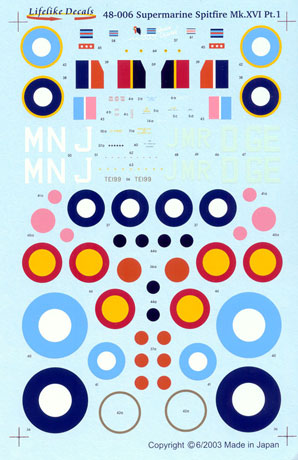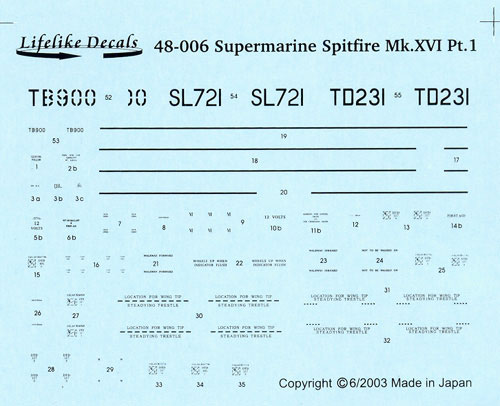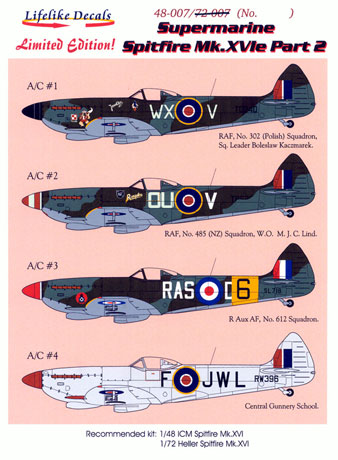|
S u m m a r y
|
| Catalogue
Number: |
Supermarine Spitfire Mk.XVIe
- 48-006 Part 1 and 48-007 Part 2 |
| Scale: |
1/48 |
| Contents and Media: |
Each set includes 1 x A5
sized decal sheet; 1 x full colour double-sided A-4 instruction
sheet; 1 x single-sided A5 sized stencil placement guide |
| Price: |
Unknown at this time |
| Review Type: |
FirstLook |
| Advantages: |
Colourful and interesting
subjects; well printed (including metallic gold) and in register;
detailed stencil data supplied; great coverage of an otherwise
neglected subject; |
| Disadvantages: |
Incorrect shade of red
(orange!) for roundels - will need replacing for relevant options |
| Recommendation: |
Recommended. |

HyperScale is proudly supported by
Squadron
Reviewed
by
Rodger Kelly
New from Lifelike Decals are two sheets covering
the bubble canopied Supermarine Spitfire Mk XVI. Each sheet covers
four different aircraft and gives you wartime as well as post-war
options. The sheets are available in both 1/48 and 1/72 scale. The
comments in this review are based on the 1/48 scale sheets.
48-006 – Spitfire XVIe Part 1
|
SL721, which was the personal
hack of Air Marshall Sir James Robb RAF. This is a well-known
aircraft and it wore different but similar markings throughout its
service life as well as its continuing civilian-operated existence.
The supplied markings depict it at the time when it served as his
personal aircraft when he was Air Officer Commanding in Chief, Fighter
Command in 1946. The machine is an overall un-documented pale blue
colour. The placement sheet advises that the exact shade of blue is
not known but it might have been a mixture of white and PRU blue. The
supplied markings comprise:
 ·
JM – R fuselage codes in RAF sky. ·
JM – R fuselage codes in RAF sky.
·
A rank ‘star plate’ consisting of
three white stars on an orange background. Unfortunately, this is
incorrect and it should be red but more on this later.
·
Air Marshal pennants.
·
SL721 serial in black.
·
National insignia in the form of type
C1 roundels for the fuselage, type C for the wings, as well as 24"
1942 -1947 fin flashes.
·
Air Vice Marshal J.M. Robb in black
lettering for the cockpit door. The placement sheet advises that the
correct lettering is not known and that they have guessed at Air Vice
Marshal J.M. Robb. Nice to see and at least they give you an option.
TB900, flown by
Squadron Leader Raymond A.F. Lallemant of 349 (Belgium) Squadron at
Fassburg, Germany during 1946. Finish is the RAF temperate scheme of
dark green, ocean grey upper surfaces over medium sea grey lower
surfaces with a sky spinner and yellow wing leading edges. The
supplied markings comprise:
·
A
Squadron Leader’s pennant
·
DG-E
Squadron codes in sky
·
Nose art consisting of a cock’s head,
the name ‘Winston Churchill’ in white, and a scoreboard consisting of
white tank silhouettes and six Balkenkruez. The black of the
Balkenkruez is supplied as a separate decal to thwart any
register problems. Why tank silhouettes? These markings stem from
the fact that Lallemant pioneered allied "tank-busting" tactics and
scored them whilst flying Hawker Typhoons. The ‘kills’ were also
earned whilst flying Typhoons.
·
TB900
serials in black. Note that the left-hand side serial is only partial
whilst the right hand side is complete. This shortened serial was
probably bought about when the sky fuselage band was overprinted.
Apparently, these bands (as well as the spinner) were over painted
when RAF aircraft were campaigning through Germany, as they tended to
negate the camouflage and stand out against surrounding countryside.
Having said that though I always wonder why the white of the upper
wing roundels was never over-painted! Lifelike has supplied the right
hand side one as a full serial as there is doubt as to the position of
it and what portion of it was over painted. Further but far smaller
and complete serials are supplied. These latter serials are applied
to the leading edge of the vertical stabilizer.
·
National insignia in the form of type
C1 roundels for the fuselage, type C for the wings, as well as 24"
1942 -1947 fin flashes.
TD231, of 350 Squadron,
Belgium Air Force, also based at Fassburg, Germany during 1946.
Finish is the RAF temperate scheme of dark green, ocean grey upper
surfaces over medium sea grey lower surfaces with a red spinner and
yellow wing leading edges. The supplied markings comprise:
·
MN-L
squadron codes in white.
·
TD231
serial in black.
·
Belgium
Air Force black, yellow and red, national insignia in six places as
well as 24" fin flashes.
TE199, another personal hack, this time flown by the Air Officer
Commanding 21 (Training) Group (Air Vice Marshal Sir Cecil Bouchier?)
at RAF Swinderby in September of 1948. An unusually marked machine to
say the least, it is in overall glossy black with a gold spinner and
wing tips. The national insignia is also unusual in that they are
pale blue and pale red. The markings comprise:
·
Type C1 national insignia for the
fuselage sides and type C for the wings. There is conjecture as to
the colour of the surrounding ring of the type C1 fuselage roundel and
a gold one is provided to overlay the integral yellow one if are
swayed by the debate.
·
24" 1942 -1947 fin flashes.
·
TE-99 serials in gold.
·
An Air Vice Marshall pennant (with a
white background rather than the more normal light blue).
Comprehensive stencil data is
provided on a separate sheet for a single aircraft with some items
being carried on the main sheet as well. The colour, style and type
of stencil data carried by these aircraft varied and the sheet also
provides these alternatives. The stencils carried by the propeller
and spinner are also included. Some of the items are very small and
will tax the patience of many. An example of this is the spinner. It
carries eight stencils that are less than 1mm in size but hey, at
least they give you the option!

What lets this sheet down is
the fact that the red used for the RAF standard type C national
insignia and fin flash is the wrong shade. As supplied, they are
orange which makes them unusable for the first two options. However,
all is not lost as they can be used for South African Air Force
markings, as the red in their national insignia was replaced by orange
so assign them to your decal bank rather than discarding them.
48-006 – Spitfire XVIe Part 1
|
TD240, flown by
Squadron Leader Boleslaw Kaczmarek of 302 (Polish) Squadron from
Varrelbusch, Germany in June-early August of 1945. . Finish is the
RAF temperate scheme of dark green, ocean grey upper surfaces over
medium sea grey lower surfaces with a black spinner and yellow wing
leading edges. The sky rear fuselage band has been over painted with
fresh paint and shows up as darker tones of each shade. The supplied
markings comprise:
 ·
Sky WX-V
squadron codes. ·
Sky WX-V
squadron codes.
·
Black
TD240 serials. The serials are in full so they must have been
re-painted over the painted-out rear fuselage band.
·
Polish
flags with the word ‘Poland’ for either side of the nose.
·
Nose art
consisting of a boxing bulldog.
·
302
Squadron insignia
·
The name
‘Janetka’ in white
·
Type C1
roundels for the fuselage sides and the upper wings, with type C for
the under sides of the wings and 24" 1942 -1947 fin flashes.
The placement guide
advises that there is some doubt with regard to the
individual-aircraft-in-squadron-letter V. Lifelike advises that the
letter could be either ‘V’ or ‘W’.
TB625, flown by Warrant
Officer Murray J.C. Lind of 485 (NZ) Squadron from Fassburg, Germany
during June-August of 1945. Finish is the RAF temperate scheme of
dark green, ocean grey upper surfaces over medium sea grey lower
surfaces with a sky spinner (that has red bands), and yellow wing
leading edges. Individual marking comprise:
·
Sky OU-V
squadron codes.
·
Black
TB625 serials. The serials are supplied in full but the placement
guide artwork shows that the left-hand side one is partially over
painted. The placement guide advises that their reference photos show
it this way but it is good to have a complete serial should you opt to
model the aircraft before the code was over painted.
·
Nose art
consisting of the New Zealand fern leaf insignia on a black shield.
·
The name
‘Rongotea’ in white with yellow shadowing.
·
A white
‘V’ on a orange (should it be red?) shield for the front of the lower
cowling.
·
Type C1
roundels for the fuselage sides, type C for the wings and 24" 1942
-1947 fin flashes.
SL718, of 612 Squadron
Royal Auxiliary Air Force in 1949. The markings depict it when it
took part in the Cooper Air Race at RAF Elmdon in 1949. Finish is the
RAF temperate scheme of dark green, ocean grey upper surfaces over
medium sea grey lower surfaces with a red spinner, and yellow wing
leading edges. On top of that, it wore a wide yellow race-marking
band around the rear fuselage. The rear Individual marking comprise:
·
White
RAS-D squadron codes. The ‘D’s are shown partially over painted by
the yellow race markings but are supplied as full letters should you
opt to model it before the race markings were applied.
·
Black
SL718 serials for the fuselage and larger ones for the lower surfaces
of the wings.
·
Nose art
consisting of a 612 Squadron badge on an orange (again, should it be
red?) circle background.
·
Black ‘6’
race numbers for the fuselage band and the upper surface of the left
wing.
·
Post-war type D roundels in six
places and 24" post-war fin flashes.
RW396 of the Central Gunnery
School, Leconfield, Yorkshire during the period 1946-1947. The
machine is in overall natural metal finish (or was it ‘high speed
silver’ lacquer?) with a red spinner and cannon barrels. Markings
consist of:
·
Black FJW-L
squadron codes.
·
Black
RW396
serials for the
fuselage and larger ones for the lower surfaces of the wings.
·
Type C1
roundels for the fuselage sides; type C for the wings and 24" 1942
-1947 fin flashes.
Again, a single full set of
stencil data is supplied on a separate sheet with the alternative and
further (read different) items.
The same error with the red
for the national insignia is present on this sheet except that the red
for the centres of the D type roundels (which are a brighter red than
the wartime ones) has been incorrectly printed in a darker red which,
by default, makes them suitable to be used for the smaller C type
roundels. The blue of the D type roundels are a bit on the light side
too.
Lifelike Decals' Keishiro
Nagao advises that the decals themselves have been printed by
Microscale and the use of the wrong colours for the roundels on both
sheets was explained as an error in research on Lifelike's behalf.
The placement guides are A-4
in size and printed on thin card in full colour. They show left hand
side profiles of each subject as well as smaller scrap views of wings
and right hand side details as appropriate. The notes provided for
each machine are quite comprehensive and advises you of any doubtful
points that may exist as well as where they got their information from
that their decisions were based on. It also lists the seven different
references consulted.
The decal sheets and the
placement guides are packed in the ubiquitous clear plastic zip-loc
bag.
Click the thumbnails below to view larger images:
The recommended kit in 1/48
scale is the ICM one (the ICM Mk XVI is the pick of their Spitfire
kits as they had their quality control problems sorted out by then)
whilst the 1/72 scale one is the Heller effort. From memory, the
Heller kit features to of the options on these sheets as the kit
decals.
I built a Mk XVI using an
Otaki kit and a Missing Link resin conversion quite a few years ago
and I remember the hassle that I went through trying to research
markings for it and the gathering of decals from several different
sheets to complete it. This sheet does all the hard work for you as
well as providing unique artwork in 1/48 scale that you wouldn't
otherwise find.
Look past the problems with
the national insignia as they are easily replaced. Hopefully, this
will be addressed when the sheets are re-printed.
Even with the above mentioned
problems, both sheets are recommended.
Recommended.
Thanks to Keishiro Nagao of Lifelike Decals for the
review sample.
Lifelike
Decals are available by email at
lifelike@eos.ocn.ne.jp or
from
2-8-7-202, Kameari,
Katsushika, Tokyo 125-0061, Japan
fax: +81-3-5680-6733 |
Home | What's
New | Features
| Gallery |
Reviews | Reference
| Forum
| Search